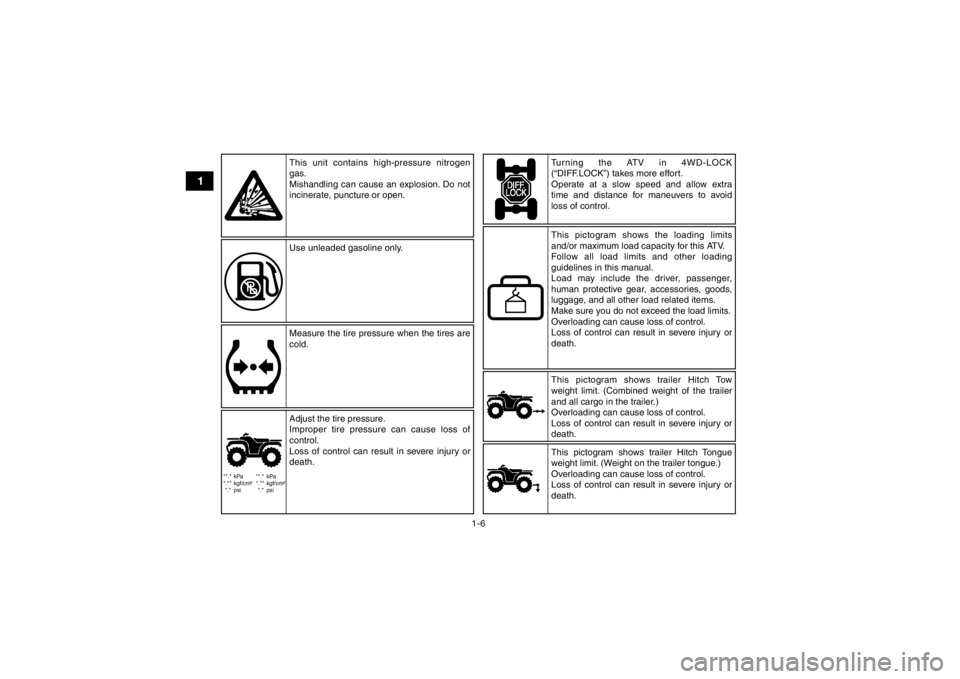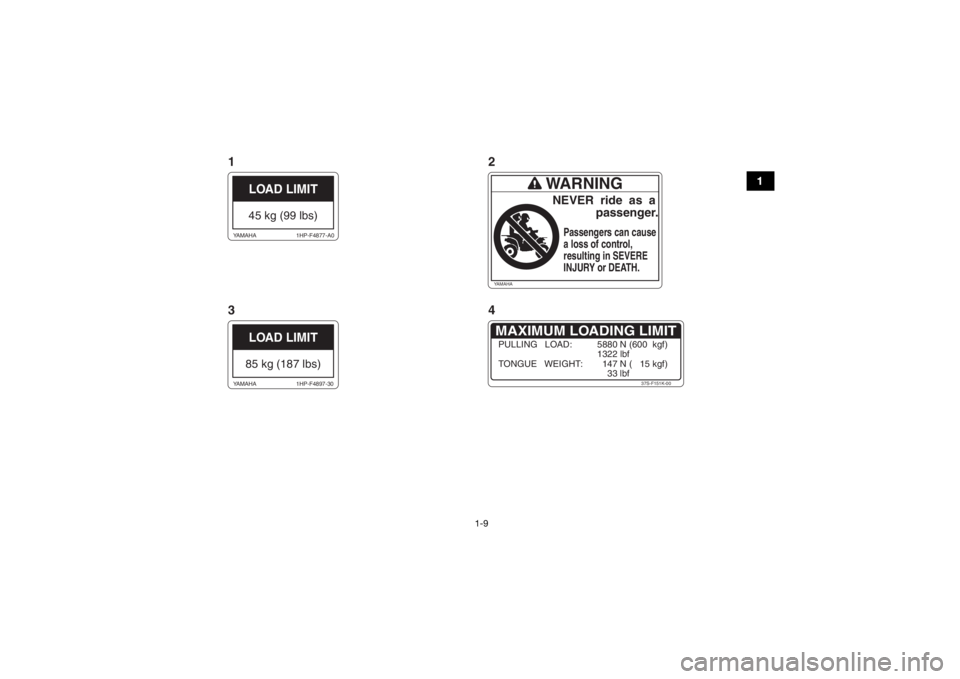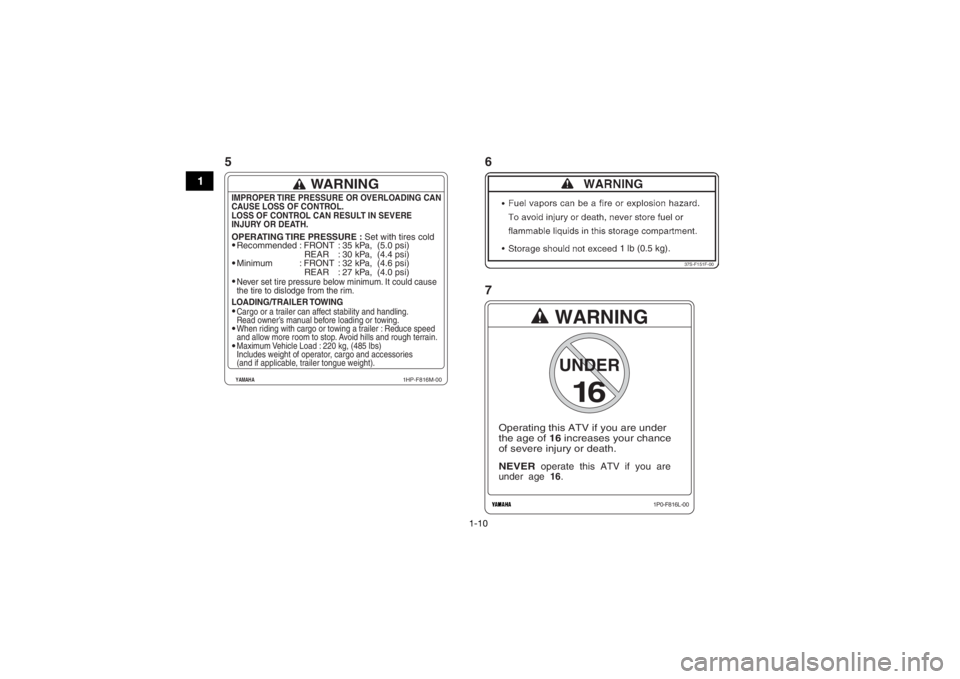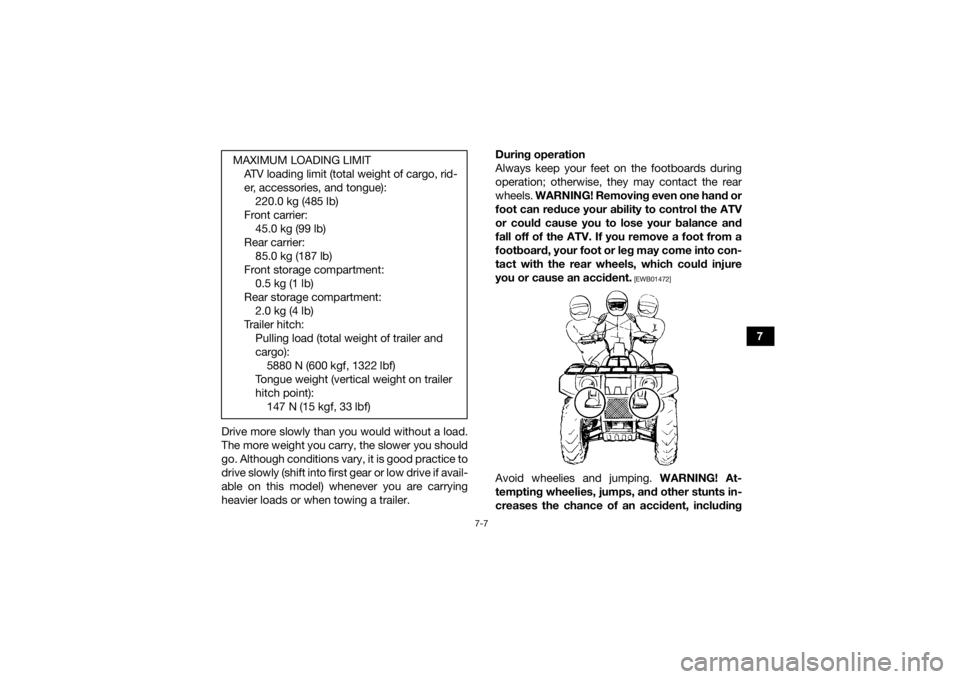weight YAMAHA GRIZZLY 700 2015 Owners Manual
[x] Cancel search | Manufacturer: YAMAHA, Model Year: 2015, Model line: GRIZZLY 700, Model: YAMAHA GRIZZLY 700 2015Pages: 172, PDF Size: 4.32 MB
Page 16 of 172

1-6
1
**.* kPa
*.** kgf/cm²*.* psi **.* kPa
*.** kgf/cm²
*.* psi
This pictogram shows trailer Hitch Tow
weight limit. (Combined weight of the trailer
and all cargo in the trailer.)
Overloading can cause loss of control.
Loss of control can result in severe injury or
death.
This unit contains high-pressure nitrogen
gas.
Mishandling can cause an explosion. Do not
incinerate, puncture or open.
Use unleaded gasoline only.
Measure the tire pressure when the tires are
cold.
Turning the ATV in 4WD-LOCK
(“DIFF.LOCK”) takes more effort.
Operate at a slow speed and allow extra
time and distance for maneuvers to avoid
loss of control.
Adjust the tire pressure.
Improper tire pressure can cause loss of
control.
Loss of control can result in severe injury or
death. This pictogram shows the loading limits
and/or maximum load capacity for this ATV.
Follow all load limits and other loading
guidelines in this manual.
Load may include the driver, passenger,
human protective gear, accessories, goods,
luggage, and all other load related items.
Make sure you do not exceed the load limits.
Overloading can cause loss of control.
Loss of control can result in severe injury or
death.
This pictogram shows trailer Hitch Tongue
weight limit. (Weight on the trailer tongue.)
Overloading can cause loss of control.
Loss of control can result in severe injury or
death.
UB3860E0.book Page 6 Monday, July 14, 2014 10:34 AM
Page 19 of 172

1-9
1
LOAD LIMIT45 kg (99 lbs)
1HP-F4877-A0
YAMAHA
LOAD LIMIT85 kg (187 lbs)
1HP-F4897-30
YAMAHA
MAXIMUM LOADING LIMIT
37S-F151K-00
PULLING LOAD: 5880 N (600 kgf)
1322 lbf
TONGUE WEIGHT: 147 N ( 15 kgf)
33 lbfYAMAHA
WARNINGNEVER ride as a
passenger.Passengers can cause
a loss of control,
resulting in SEVERE
INJURY or DEATH.
1 2
3 4
UB3860E0.book Page 9 Monday, July 14, 2014 10:34 AM
Page 20 of 172

1-10
1
1 lb (0.5 kg).
37S-F151F-00
Recommended
Minimum: FRONT
REAR
: FRONT
REAR: 35 kPa, (5.0 psi)
: 30 kPa, (4.4 psi)
: 32 kPa, (4.6 psi)
: 27 kPa, (4.0 psi)Never set tire pressure below minimum. It could cause
the tire to dislodge from the rim.Cargo or a trailer can affect stability and handling.
Read owner’s manual before loading or towing.
When riding with cargo or towing a trailer : Reduce speed
and allow more room to stop. Avoid hills and rough terrain.
Maximum Vehicle Load : 220 kg, (485 lbs)
Includes weight of operator, cargo and accessories
(and if applicable, trailer tongue weight).
WARNING
1HP-F816M-00
YAMAHAIMPROPER TIRE PRESSURE OR OVERLOADING CAN
CAUSE LOSS OF CONTROL.
LOSS OF CONTROL CAN RESULT IN SEVERE
INJURY OR DEATH.OPERATING TIRE PRESSURE : Set with tires coldLOADING/TRAILER TOWING
WARNING
NEVER
operate this ATV if you are
under age 16.Operating this ATV if you are under
the age of 16 increases your chance
of severe injury or death.
16
UNDER
1P0-F816L-00
56
7UB3860E0.book Page 10 Monday, July 14, 2014 10:34 AM
Page 23 of 172

2-2
2
Never operate at speeds too fast for your skills
or the riding conditions. Always go at a speed
that is proper for the terrain, visibility, operating
conditions, and your experience.
Never attempt wheelies, jumps, or other stunts.
Always inspect your ATV each time you use it to
make sure it is in safe operating condition. Al-
ways follow the inspection and maintenance
procedures and schedules described in this
manual.
Always keep both hands on the handlebars and
both feet on the footboards of the ATV during
operation.
Always go slowly and be extra careful when op-
erating on unfamiliar terrain. Always be alert to
changing terrain conditions when operating the
ATV.
Never operate on excessively rough, slippery or
loose terrain until you have learned and prac-
ticed the skills necessary to control the ATV on
such terrain. Always be especially cautious on
these kinds of terrain.
Always follow proper procedures for turning as
described in this manual. Practice turning at low
speeds before attempting to turn at faster
speeds and never turn at excessive speeds.
Never operate the ATV on hills too steep for the
ATV or for your abilities. Practice on smaller hills
before attempting larger hills.
Always follow proper procedures for climbing
hills as described in this manual. Check the ter-
rain carefully before you start up any hill. Never
climb hills with excessively slippery or loose
surfaces. Shift your weight forward. Never open
the throttle suddenly. Never go over the top of a
hill at high speed.
Always follow proper procedures for going
down hills and for braking on hills as described
in this manual. Check the terrain carefully before
you start down any hill. Shift your weight back-
ward. Never go down a hill at high speed. Avoid
going down a hill at an angle that would cause
the vehicle to lean sharply to one side. Go
straight down the hill where possible.
Always follow proper procedures for crossing
the side of a hill as described in this manual.
Avoid hills with excessively slippery or loose
surfaces. Shift your weight to the uphill side of
the ATV. Never attempt to turn the ATV around
on any hill until you have mastered the turning
UB3860E0.book Page 2 Monday, July 14, 2014 10:34 AM
Page 26 of 172

2-5
2ungrounded or broken wiring. Visually check
for broken wiring and leaking fuel. Leaking
fuel can be confirmed by the odor of gasoline.
4. Once immediate safety hazards are con- firmed not to exist, you may remove your hel-
met to more closely inspect your vehicle.
Check for external signs of wear, broken
parts, fluid leaks, cracks in the frame, sus-
pension damage, wheel damage, and so on.
Fuel, oil, and coolant usually give off a notice-
able odor.
5. If your vehicle will not restart or if it is unsafe to ride, then turn off all vehicle systems (en-
gine stop switch, main switch, and fuel cock),
and then signal or go for help.
Aftermarket Parts, Accessories, and Modifica-
tions
While you may find aftermarket products similar in
design and quality to genuine Yamaha accesso-
ries, recognize that some aftermarket accessories
or modifications are not suitable because of po-
tential safety hazards to you or others. Installing
aftermarket products or having other modifica-
tions performed to your vehicle that change any of
the vehicle’s design or operation characteristics
can put you and others at greater risk of serious injury or death. You are responsible for injuries re-
lated to changes in the vehicle. Keep the following
guidelines in mind, as well as those provided un-
der “Loading” when mounting accessories.
Never install accessories that would impair the
performance of your ATV. Carefully inspect the
accessory before using it to make sure that it
does not in any way reduce ground clearance,
limit suspension travel, steering travel or control
operation.
Accessories fitted to the ATV can create insta-
bility due to improper weight distribution.
Bulky or large accessories may seriously affect
the stability of the ATV.
Certain accessories can displace the operator
from his or her normal riding position. This im-
proper position limits the freedom of movement
of the operator and may limit control ability,
therefore, such accessories are not recom-
mended.
Use caution when adding electrical accesso-
ries. If electrical accessories exceed the capac-
ity of the ATV’s electrical system, an electric
failure could result, which could cause a dan-
gerous loss of lights or engine power.
UB3860E0.book Page 5 Monday, July 14, 2014 10:34 AM
Page 50 of 172

4-21
4
EBU18963Front carrierDo not exceed the load limit of 45.0 kg (99 lb) for
the front carrier.
Do not exceed the maximum load of 220.0 kg
(485 lb) for the ATV.EBU18973Rear carrierDo not exceed the load limit of 85.0 kg (187 lb)
for the rear carrier.
Do not exceed the maximum load of 220.0 kg
(485 lb) for the ATV.EBU19147Adjusting the front and rear shock ab-
sorber assembliesThe spring preload can be adjusted to suit the rid-
er’s weight and the riding conditions.
WARNING
EWB00401Always adjust the shock absorber assemblies
on the left and right side to the same setting.
Uneven adjustment can cause poor handling
and loss of stability, which could lead to an ac-
cident.
1. Storage compartment drain plug
1. Storage compartment drain plugUB3860E0.book Page 21 Monday, July 14, 2014 10:34 AM
Page 67 of 172

6-7
6
bulky object attached to the handlebars which
could make steering difficult, an accessory that
limits your ability to move around on the seat, or
one that limits your view.
Use extra caution when riding an ATV with ac-
cessories. The ATV may handle differently than
it does without accessories.
EBU27572Loading
WARNING
EWB00821Never exceed the stated load capacity for this
ATV. Overloading this ATV or carrying or tow-
ing cargo improperly could cause changes in
ATV handling which could lead to an accident.
Cargo should be properly distributed and se-
curely attached. Reduce speed when carrying
cargo or pulling a trailer. Allow greater dis-
tance for braking. Cargo or a trailer can change the stability and han-
dling of an ATV.
You must use common sense and good judgment
when carrying cargo or towing a trailer. Keep the
following points in mind:
Never exceed the weight limits shown. An over-
loaded ATV can be unstable.
Do not exceed the maximum tongue weight.
You can measure tongue weight with a bath-
room scale. Put the tongue of the loaded trailer
on the scale with the tongue at hitch height. Ad-MAXIMUM LOADING LIMIT
ATV loading limit (total weight of rider, car-
go, accessories, and tongue):220.0 kg (485 lb)
Front carrier: 45.0 kg (99 lb)
Rear carrier: 85.0 kg (187 lb)
Front storage compartment: 0.5 kg (1 lb)
Rear storage compartment: 2.0 kg (4 lb)
Tr a i l e r h i t c h : Pulling load (total weight of trailer and
cargo): 5880 N (600 kgf, 1322 lbf)
Tongue weight (vertical weight on trailer
hitch point): 147 N (15 kgf, 33 lbf)UB3860E0.book Page 7 Monday, July 14, 2014 10:34 AM
Page 68 of 172

6-8
6just the load in the trailer, if necessary, to reduce
the weight on the hitch. If you are carrying cargo
and towing a trailer, include the tongue weight
in the maximum ATV load limit.
Load cargo on the carriers as close to the center
of the ATV as possible. Put cargo at the rear of
the front carrier, at the front of the rear carrier,
and center it.
Tie down cargo securely to the carriers. Make
sure cargo in the trailer cannot move around. A
shifting load can cause an accident.
Make sure the load does not interfere with con-
trols or your ability to see where you are going.
Ride more slowly than you would without a
load. The more weight you carry, the slower you
should go. Although conditions vary, it is good
practice not to exceed low range whenever you
are carrying heavier loads or when towing a
trailer.
Allow more braking distance. A heavier ATV
takes longer to stop.
Avoid making sharp turns unless at very slow
speeds.
Avoid hills and rough terrain. Choose terrain
carefully. Added weight affects the stability and
handling of the ATV.
UB3860E0.book Page 8 Monday, July 14, 2014 10:34 AM
Page 74 of 172

7-6
7fully opening, even when the throttle lever is
pushed to the maximum. Turning in the adjusting
screw limits the maximum engine power available
and decreases the maximum speed of the ATV.
Turning in the adjusting screw decreases top
speed, and turning it out increases top speed.
(See page 4-13.)
Loading and accessories
WARNING
EWB01463Improper loading or towing can increase the
risk of loss of control, an overturn, or other ac-
cident. To reduce the risk of an accident:
Do not exceed the maximum loading limits
for the vehicle (see “MAXIMUM LOADING
LIMIT” in this section or vehicle labeling).
Keep weight on racks centered side to side,
and as low as possible. Be sure cargo is se-
cured – a loose load could change handling
unexpectedly.
Make sure the load does not interfere with
your control or ability to see where you are
going.
Tie down cargo in the trailer securely. Make
sure cargo in the trailer cannot move around.
A shifting load can cause an accident.
Reduce speed and allow more room to stop.
A heavier vehicle takes longer to stop.
Avoid hills and rough terrain. Choose terrain
carefully. Use extreme caution when towing
or carrying a load on inclines.
Turn gradually and go slowly.
Take extra precautions when driving with a load or
trailer. Follow these instructions and always use
common sense and good judgment when carrying
cargo or towing a trailer.
1. Adjusting screw
1
UB3860E0.book Page 6 Monday, July 14, 2014 10:34 AM
Page 75 of 172

7-7
7
Drive more slowly than you would without a load.
The more weight you carry, the slower you should
go. Although conditions vary, it is good practice to
drive slowly (shift into first gear or low drive if avail-
able on this model) whenever you are carrying
heavier loads or when towing a trailer. During operation
Always keep your feet on the footboards during
operation; otherwise, they may contact the rear
wheels.
WARNING! Removing even one hand or
foot can reduce your ability to control the ATV
or could cause you to lose your balance and
fall off of the ATV. If you remove a foot from a
footboard, your foot or leg may come into con-
tact with the rear wheels, which could injure
you or cause an accident.
[EWB01472]
Avoid wheelies and jumping. WARNING! At-
tempting wheelies, jumps, and other stunts in-
creases the chance of an accident, including
MAXIMUM LOADING LIMIT
ATV loading limit (total weight of cargo, rid-
er, accessories, and tongue):220.0 kg (485 lb)
Front carrier: 45.0 kg (99 lb)
Rear carrier: 85.0 kg (187 lb)
Front storage compartment: 0.5 kg (1 lb)
Rear storage compartment: 2.0 kg (4 lb)
Tr a i l e r h i t c h : Pulling load (total weight of trailer and
cargo): 5880 N (600 kgf, 1322 lbf)
Tongue weight (vertical weight on trailer
hitch point): 147 N (15 kgf, 33 lbf)
UB3860E0.book Page 7 Monday, July 14, 2014 10:34 AM